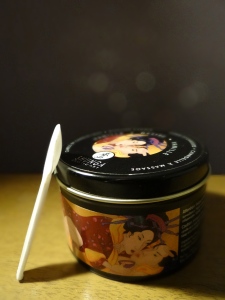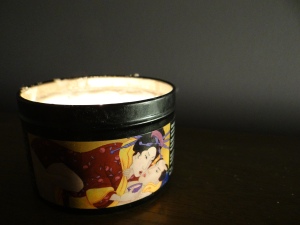What’s more sensual than hot wax and a body massage? If you’re like me, then the answer is nothing. Massage candles are a necessity in my bedroom. They provide the perfect blend of arousal and relaxation. Pain and pleasure. Plus, they evoke not only the sense of touch, but smell as well — a sense that is often ignored in sexual activity.
Massage candles are body-safe candles that melt at low temperatures to create a warm massage oil. Shunga’s line of “Caress by Candlelight” massage candles come in 4 scents: rose, vanilla, lavender, and exotic fruits. Their 7 oz. candle costs approximately $20, (depending on where you shop), has a 45 hour burn time, and comes in a small black tin. Since the container does not have a spout, a small plastic spoon is included for the melted oil.
I own Shunga’s vanilla candle, and I could not be happier with the scent! It’s a delightful, non-waxy smell that reminds me of warm cookies, fresh out of the oven and full of butter and sugar. This may seem more hunger-inducing than romantic, but somehow it works. The scent is quite relaxing.
The directions say to ‘Light the candle, wait 20 minutes and extinguish the flame. Pour the melted wax into the palm of your hand. (The oil will be warm, but not burning hot.)’
For the impatient individuals out there, you’ll be happy to know that the candle begins to melt within just a few minutes. However, allowing 20 minutes of burn time will, of course, create a larger puddle of oil to pull from. (It also provides a nice excuse to slow down and spend more time on other types of foreplay. Hint, hint.)
When obeying the directions and extinguishing the candle before use, I found that the oil cooled rather quickly. This would mostly become a problem when enjoying a long massage. My partner or I would stop to reapply the oil only to find that it had already hardened inside the tin container. This can be an unfortunate stopping (or pausing) point if you’re really into the massage.
Also, although the ‘warm, but not burning hot’ oil was very relaxing, I was left wanting a more intense sensation. Since this is a low-temperature candle, I decided to ignore the directions and experiment by leaving the candle burning during use. (As you may have noticed, the close proximity to the flame has melted my tiny plastic spoon.) While the use of the spoon does allow a few seconds for the oil to cool before it comes into contact with skin, it will still provide the quick, intense heat of ‘hot wax’ and redden the area for a short time. Of course, wax play safety measures are of the upmost importance.
Whether you’re into ‘warm’ or ‘hot’ sensations, the heat of the oil mixed with the body heat from your partner’s hands is simply fantastic. A spoonful or two provides enough oil to effortlessly glide across your lover’s skin — but not so much that it creates a slippery mess. It also absorbs into the skin much better than I had expected. I was pleasantly surprised that, even when it dried, my skin did not feel uncomfortably sticky or greasy. In fact, when the wax has been fully melted and the oil has been completely worked into my skin, I feel rather moisturized. (It also makes me smell delicious!)
For those curious folks with sensitive skin, the ingredients list includes hydrogenated soybean oil, coconut oil, fragrance, sweet almond oil, safflower oil, avocado oil, sesame oil, grape seed oil, and vitamin E.
Would I suggest Shunga’s “Caress by Candlelight” massage candles? Most definitely! They are a simple addition to the bedroom that can provide a range of different sensations & experiences. Their scented natural oils are a treat for the skin — not a nightmare of oily residue. Plus, they’re very inexpensive when you consider the many hours of fun you can have with just one candle.
You can purchase Shunga Massage Candles from Shevibe here.




